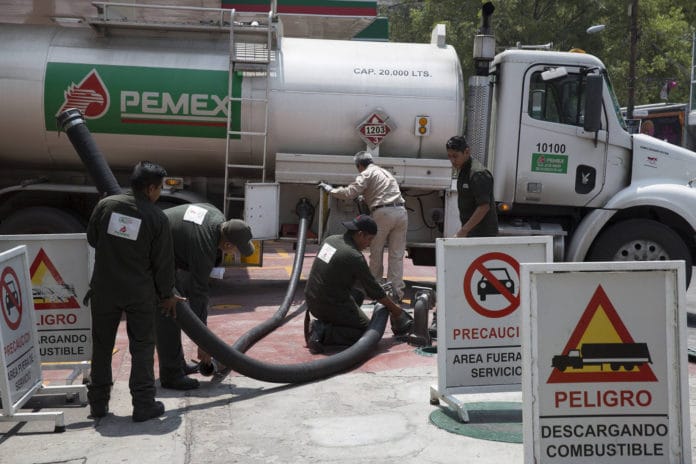In Mexico, the era of big oil is just getting started. But for the state oil dinosaur, its best days appear to be behind it.
The reign of Petroleos Mexicanos, the government-owned oil producer known as Pemex, is slowly being dismantled after a 2013 overhaul ended its monopoly and opened up the industry to foreign rivals for the first time in more than seven decades. A Dec. 5 auction in which oil majors including Exxon Mobil Corp., Chevron Corp. and BP Plc may bid on deepwater blocks marks the most significant step yet in Mexico’s effort to reclaim its spot as a global crude-producing powerhouse.
Mexico needs the auction to be a hit. Out of the gate, the industry overhaul suffered a major blow when the country’s oil prices collapsed from above $100 a barrel in 2014 to as low as $19 a barrel in January. The drop stymied participation in the nation’s debut auctions last year, while accelerating the decline of Pemex, once the world’s third-largest producer. All of that raises the stakes for next week’s sale.
“What we’re seeing right now is the ongoing impact of years of neglect of the national oil company,” Duncan Wood, director of the Mexico Institute at the Woodrow Wilson International Center for Scholars in Washington, said in a phone interview. “Without the energy reform, Pemex was on a road to bankruptcy. The country is now trying to right the sinking ship, but it still might be as many as 10 years before the entrance of significant investment can help do that.”
Today, Pemex’s output is falling faster than foreign producers will be able to ramp up production, even if the auction on Monday is a success. Its production is on course to fall to a 36-year low as the Mexico City-based company is hogtied by nearly $100 billion in debt and 16 straight quarterly losses that have decimated investment spending.
The fall in Pemex’s oil production can be attributed to the maturation and decline of the Cantarell field, Pemex said in an emailed statement. Cantarell was one of the world’s largest oil discoveries when found in the Gulf of Mexico in the 1970s.
The most ambitious of the promises included in the oil industry reforms are already at risk. When the law was signed in December 2013, President Enrique Pena Nieto vowed it’d lead to thousands of jobs, increased output and a stronger, more efficient Pemex. Instead, Pemex has reduced its staff by almost 30,000, and local service companies that counted the oil monopoly as its only client were forced to freeze activities or shut down because of delayed payments and cut contracts. One of the energy overhaul’s key milestones — hitting national production of 3 million daily barrels by 2018 — is likely to fall short by more than a third.
Once a bigger supplier to the U.S. than Saudi Arabia, Pemex’s output may dwindle to about 1.6 million barrels a day by 2020, less than half its 2004 peak, because it lacks the technology and funds to revamp aging fields, Morgan Stanley analysts said in July. Without sufficient liquidity and investment, Pemex will continue to shrink, they said.
Pemex’s priority in the upcoming years is to be profitable, which will require slowing the accumulation of debt and improving midstream and downstream operations, Pemex said in an e-mail. The company said it aims to increase profitability without further job cuts.
Government officials are also hoping Monday will signal the start of the turnaround for Pemex, as well as the oil industry. The blocks up for grabs are by far the sexiest of the nation’s potential crude reserves, often referred to as the country’s “crown jewels” by Energy Minister Pedro Joaquin Coldwell. More than three-fourths of prospective oil resources are located offshore in deep waters, according to the energy ministry.
“We’ve attracted some of the largest companies in the world that have the technology and investment capacities to develop deep water resources,” Hector Moreira, a commissioner for the Mexican oil regulator and a former Pemex board member, said Nov. 28 in a meeting to announce the companies that would participate in the Dec. 5 auction. “This is a result of the energy reform.”
Also up for sale is a joint-venture stake with Pemex. The deal would create the company’s first-ever partner in deep waters at the Trion light-crude field in the Gulf of Mexico just south of the maritime border with the U.S. Pemex forecasts that $11 billion in investment will be needed to develop Trion, which the company says holds as many as 485 million barrels of oil equivalent.
Pemex expects to see investments from the partnership in the Trion field as soon as 2017, Jose Antonio Gonzalez Anaya, the company’s chief executive officer, said today in an interview with Bloomberg Television. The field is expected to record crude production as soon as 2022, he said.
“The only way to make Pemex wake up and push it to the next level is through competition,” said Juan Francisco Torres-Landa, managing partner of Hogan Lovells’ Mexico City office. “It is going to have to be a much more efficient company or it won’t be able tocompete.”






